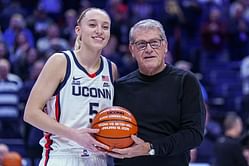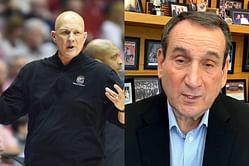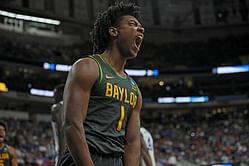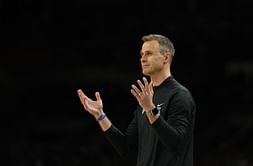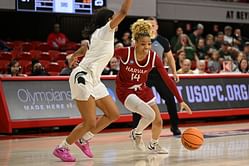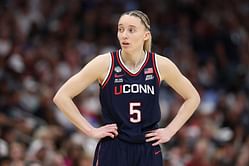
March Madness is the name given to the Division I men's basketball tournament by the National Collegiate Athletic Association. It is a single-elimination event in the United States that determines the national champion in men's collegiate basketball.
First played in March, the competition has 68 teams and was held for the first time in 1939. Known for upsetting favorite teams, it has become one of the largest annual sporting events in the United States. The 32 conference winners make up the tournament teams, with 36 other schools that receive at-large berths. These teams are announced on Selection Sunday, a nationally televised event, subsequent to their selection by an NCAA selection committee.
A total of 37 different schools have won the event. UCLA has won the most championships with 11, while their coach, John Wooden, has won the most of any coach with 10. University of Kentucky has won eight titles, followed by the University of North Carolina and University of Connecticut with six, Indiana University and Duke University with five. Seven universities are tied for two national titles, while 22 teams have won one each.
How does March Madness work?
March Madness features 68 teams competing in a single-elimination bracket over seven rounds. A total of 36 teams receive an at-large bid based on their season performance, while 32 teams automatically qualify for the tournament by winning their conference tournament, which is held during the two weeks leading up to the tournament.
The Sunday before the tournament, known as Selection Sunday by the media and fans, is when the Selection Committee makes public the decisions on the at-large bids, ranks all of the teams from 1 to 68, and arranges the teams in the bracket. There is no reseeding during the competition, and the bracket determines the pairings for each successive round. Four regions, consisting of 16 to 18 teams each, make up the event; they vary annually.
Three weekends are allocated for the tournament, with two rounds taking place each weekend. Eight teams participate in the First Four to go to the first round prior to the first weekend. The lowest-ranked at-large qualifiers and conference champions are paired in two games each.
The national semifinals and championship games take place on the third weekend, whereas the first and second rounds, regional semifinals, and regional finals take place on the first and second weekends, respectively.
According to the number of teams left at the start of the round, the regional stages are called the Sweet Sixteen and Elite Eight, while the third weekend is called the Final Four. Every match, including the First Four, is arranged to give teams one day off in between.
| Round | Teams Rem. | Teams Comp. | Games | Week | Dates |
| First Four (play-in round) | 68 | 8 | 4 | 1st | Tuesday & Wednesday |
| First round | 64 | 64 | 32 | Thursday & Friday | |
| Second round | 32 | 32 | 16 | Saturday & Sunday | |
| Sweet Sixteen (regional semifinals) | 16 | 16 | 8 | 2nd | Thursday & Friday |
| Elite Eight (regional finals) | 8 | 8 | 4 | Saturday & Sunday | |
| Final Four (national semifinals) | 4 | 4 | 2 | 3rd | Saturday |
| Championship game | 2 | 2 | 1 | Monday |
Which year did March Madness start?
In 1939, the first-ever NCAA Division I men's basketball tournament took place. Eight teams participated in the tournament. Oregon defeated Ohio State to win the inaugural NCAA tournament. In 1951, there were 16 participants in the NCAA tournament; in 1975, that number doubled to 32, and in 1985, the field swelled to 64 teams. In 2001, one opening-round match was added. In 2011, the first-ever First Four saw the addition of three more games to that round.
Henry V. Porter, a high school official in Illinois, coined the phrase "March Madness" for basketball in 1939. It wasn't until Brent Musberger coined the phrase during coverage of the 1982 tournament that March Madness became linked with the NCAA tournament. The March Madness anthem, One Shining Moment, debuted after the 1987 NCAA men's basketball tournament. The NIT (1938) was established prior to the NCAA tournament. As the first 16-seed to defeat a 1-seed, UMBC pulled off the largest upset in March Madness history.
Discover: When does March Madness Start?
When did March Madness start?
The term "March Madness" for basketball was first used in 1939 by Henry V. Porter, an Illinois high school official. However, it was the 1982 competition that established the connection between March Madness and the NCAA tournament.
There were just eight teams competing in the first NCAA basketball tournament, and Ohio State lost to Oregon in the championship game in 1939. The field of 16 teams entered the NCAA tournament in 1951, it expanded to 32 in 1975, and it grew to 64 teams in 1985. One match in the opening round was added in 2001. There were three more games added to the first-ever First Four in 2011.
How long is a March Madness game?
The average length of an NCAA Tournament game is two hours. This could change based on the final score and whether overtime is used in the match. A game lasts 40 minutes altogether, divided into two 20-minute halves. Five minutes are allotted for overtime. There are sometimes a lot more timeouts in close games because coaches need time to plan plays in pressure-filled scenarios or manage the clock.
In addition, there are far more foul-related stops in play since teams purposely foul to lengthen the game and halt the clock. Teams in the tournament will continue to foul even when the game is probably out of reach because they are desperate to keep their seasons going. Games in tournaments are therefore longer than those in the regular season.
What is the First Four in March Madness?
The First Four of the NCAA Tournament is regarded as the unofficial (play-in games) beginning of March Madness, the greatest postseason in American sports history. After Selection Sunday, the First Four teams play on Tuesday and Wednesday, with the first round starting on Thursday.
Eight teams compete in the current First Four format: four automatic bids from the lowest seed and four at-large bids from the lowest seed. Two of the four games involving those teams are at the 16-seed line, and the other two are at the 11- or 12-seed line.
Also read: How can I watch March Madness?
FAQs on March Madness
A. March Madness is the NCAA Division I men's basketball tournament, a single-elimination event held annually to determine the national champion.
A. March Madness features 68 teams in a single-elimination bracket over seven rounds, with teams determined by at-large bids and conference winners.
A. March Madness started in 1939, with the term coined in 1939 by Henry V. Porter and gaining prominence in the 1982 competition.
A. A March Madness game lasts about two hours on average, with each half lasting 20 minutes and additional time for overtime and timeouts.
A. The First Four is the start of March Madness, featuring eight teams playing in the NCAA tournament.


